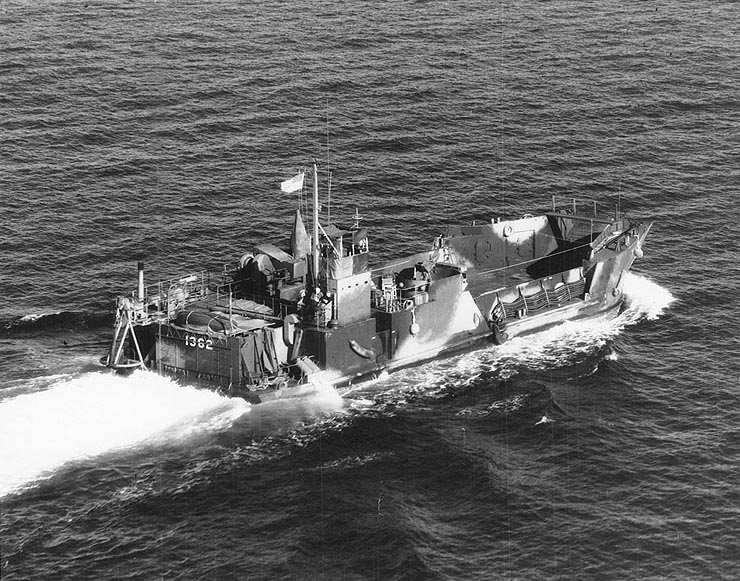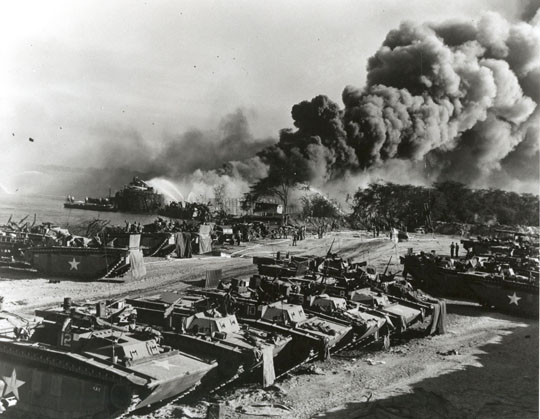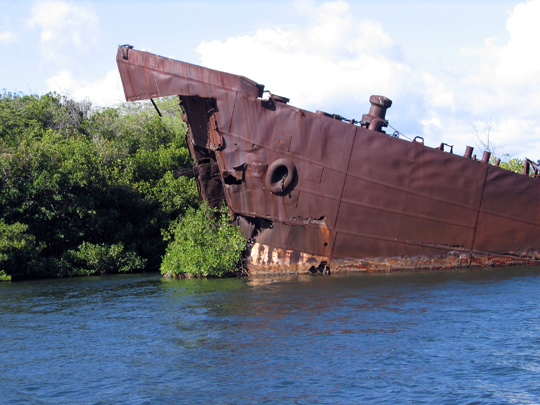The Hazards of Training
Part of Maui's Military Legacy: Training Losses?
The two aircraft surveyed by the 2011 dive team represent non-combat accidents which occurred during intensive training or normal operations spanning the war years. Young pilots, gunners, and radiomen found themselves flying in close formation and unfamiliar environments. The high level of activity has left a large naval aviation resource in local waters. For the period of 1924-1952, records reveal 1,484 aircraft losses in the Hawaiian Islands. (Of those, only two dozen have been located.) These statistics are strong testimony to the dedication, courage, and the inherent hazards involved in the history of naval aviation.
The specific identities and events which led to the loss of the three amphibious assault vehicles are not known. All three of the LVTs were first deployed in combat during the Saipan invasion, so it is possible that they were lost during the weeks of preparations prior to Operation Forager or subsequent operations (Tinian, Iwo Jima etc). With the assistance of historian Bob Cressman at the Naval History & Heritage Command, records pertaining to some LVT losses have come to light. From the ship's history file for LST-564:
Underway at 0712 on 1 September 1944, LST-564 participated in exercises at Maalaea Bay, Maui, embarking Army assault troops...launching and recovering LVTs, less two of the amphibian tractors that sank because of clogged bilge pumps. She anchored for the night in Maalaea Bay...The motor minesweeper YMS-311 came alongside at 1038 to transfer the survivors of the LVTs lost the previous day. Still later in that watch, Ens. Prendergast and a small boat crew, S2c Sendak, S1c Moore, S2c Beshers and F1c Wood reported back to the ship after the ship's number five boat had broached when attempting to pass a towline to a floundering LVT. Further training with LVTs continued on the 3rd
Unfortunately, there is no way to positively associate this training record with the LVT sites in Mākena Bay. The record therefore serves only to demonstrate the hazards and multiple losses involved in amphibious training operations.
The Tragic Loss of Three LCT's

On May 15, 1944, a line of LST's (amphibious ships) were headed from Mā`alaea Bay back to Pearl Harbor, filled with men and material destined for the invasion of Saipan. These particular ships had been modified to carry other landing craft, 120-foot long LCT's, on their decks. In the middle of the night the rough seas in the channel caused the large ships to roll to the point that the fastenings attaching the LCTs to the decks carried away.
LCT-984 slid from the deck and struck the water with engine room doors open and bow ramp down. The vessel quickly became waterlogged and semi-submerged. On board LST-71 men of the 8th Marine Division were sleeping on the deck and inside their LCT. When LCT-988 fell into the ocean, the next ship in the convoy, LST-29, accidentally rammed the landing craft, causing her to immediately capsize. Eldon Ballinger (Marine Corps League newsletter, n.d.) relates part of the story:
The division was assigned 22 LST's and in the well decks were Amphtracs. We pulled practice landings at Maalaea Bay on Maui and also a mock invasion of Kahoolawe Island...Around 2330 the sea began to get rough and within a two hour period the sea became very turbulent with high waves. The flat bottomed LST rocked back and forth so violently that the straps broke on the stacks of ammunition, falling on the sleeping men. Then the steel cables snapped, releasing the LCT, ripping the large skid beams loose, and the waves washed everything off the deck of the LST's starboard side. The LCT hit the water right-side up, except the ramp was down. I remember a crewman and I were trying to start the engine so that the ramp could be raised. It was then that the trailing LST hit us broadside, flipping the LCT completely upside down. The LCT sank within minutes with those that were still alive going down with the ship.
LCT-999 was also swept into the ocean, but fortunately was later recovered and towed to Pearl Harbor. In all the series of LCT accidents resulted in some 19 men dead or missing (the exact number is not clear).

Explosions at West Loch: No Escape from Danger
Tragedy struck again only days after the LCT losses. The explosion of multiple ammunition ships at West Loch on May 21, 1944 has been called Hawai`i's second greatest naval disaster after the attack on Pearl Harbor. During preparations for the invasion of Saipan, 29 LSTs were loading ammunition from the naval magazine at Hanaloa Point. Due to limited space, these vessels were crowded closely together in Pearl Harbor's West Loch. At 3:08 PM a large explosion ripped through LST-353, originating near the bow of LCT-963, where troops from Schofield Barracks were unloading mortar ammunition. Burning debris showered down around gasoline drums, and a chain reaction of explosions soon sank six large LSTs and three LCTs. In all, 163 men died and 396 were wounded. Fires burned for more than 24 hours and more than 20 buildings on shore were damaged.

Many continue to remain unaware of the West Loch accident because the mishap was immediately subject to military censorship. The first memorial service for the nearly all-black Schofield Army unit (suffered more than a third of the casualties) was held at the National Memorial Cemetery of the Pacific on May 21, 2009. During the war, sacrifices in both training and combat can be equally as tragic.

